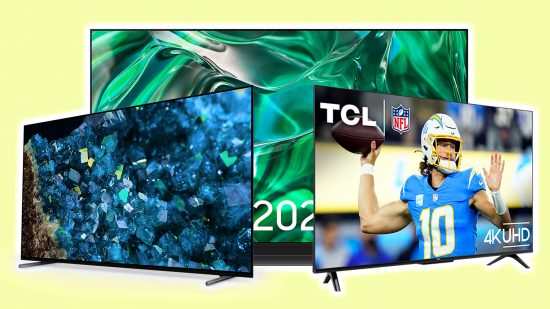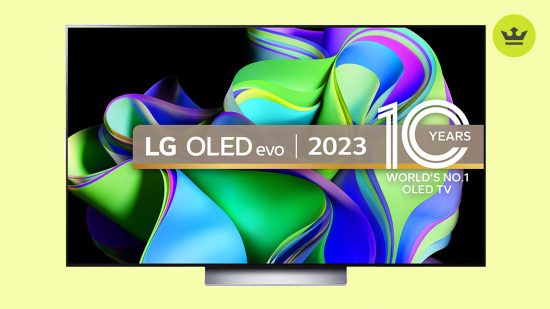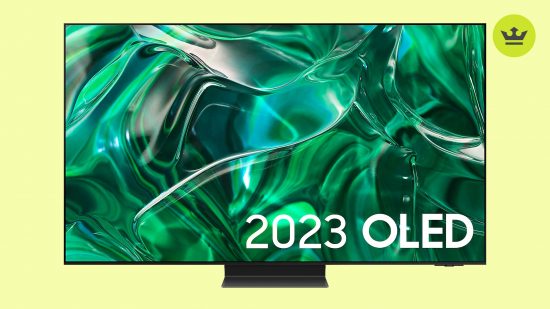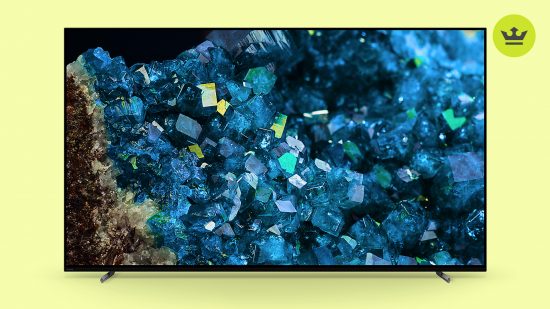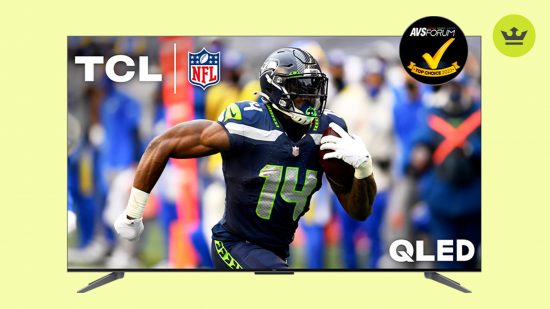Having the best TV for PS5 and Xbox Series X is the easiest way to upgrade your console gaming setup. While the screens of yesteryear often neglected dedicated gaming features, most manufacturers now have products with the best gaming consoles in mind.
While our best gaming TV guide has options for every console, here we’ve picked the best TV for PS5 and Xbox Series X right now. Gone are the days of high-latency, low refresh rate panels, as established brands like LG, Samsung, and Sony are imbuing the best PS5 and Xbox Series X TVs with everything from 144hz support to dedicated low-latency gaming modes. Some even sport AMD’s FreeSync or NVIDIA’s G-Sync technology to reduce screen tearing while you’re zooming around using the best Xbox steering wheels.
Gamers on a budget now have more choices than ever before, as the likes of Hisense and TCL have revolutionized the lower end of the pricing scale. And thanks to technologies like HDR 10+ and Dolby Vision, LED, and QLED, the best TVs have never looked better.
The best TVs for PS5 and Xbox Series X:
- LG G3 – Best TV overall
- Samsung S95C – Best 144Hz TV
- Sony A80L – Best mid-range TV for PS5
- TCL Q7 – budget TV for 120Hz+ gaming
- TCL S4 – budget TV for 60Hz gaming
1. LG G3
Best TV for PS5 and Xbox Series X for most.
LG G3 specs:
| Available sizes | 42/48/55/65/77/83 inches |
| Panel type | OLED |
| Max resolution | 4K @ 120Hz |
| HDR | Dolby Vision, HDR10, HLG |
| Connectivity | 4x HDMI 2.1 (eARC) |
| Key features | Micro Lens Array, AI Sound Pro, a9 AI Processor 4K Gen6, 40W 2.2 channel speaker system, Dolby Atmos, DTS |
| Gaming features | NVIDIA G-Sync, AMD FreeSync Premium, Auto Low Latency Mode (ALLM), Game Dashboard and optimizer |
Pros
- MLA technology makes for an incredibly bright screen
- Immense picture quality under all lighting conditions
- The included mount removes an expense
Cons
- Lack of stand may incur an expense
- Sound quality could be better for the price
- MLA only comes with 55/65/77-inch models
As our pick for the best TV, the G3 is designed to feature prominently in your main living or gaming area. Whereas 2022 was dominated by the emergence of Quantum Dot OLED, or ‘QD-OLED’ technology, LG has bit back with its innovation in the form of Micro Lens Array (‘MLA’) panels. Historically, OLED TVs have struggled to reach the same innate brightness as LCDs without manufacturers pushing them to the point that burn-in could occur. With MLA, LG has been able to capture excess light and channel it in a way that produces ridiculously bright pictures, while mitigating the risk of burn-in. The result of this when combined with LG’s sixth-generation a9AI processor is a stunning image that will hold up even on the sunniest days, without compromising the depths of its perfect blacks.
While the G3 will only push its panel as far as 4K 120Hz on the refresh rate front, that’s more than suitable for both the PS5 and Xbox Series X which wouldn’t be able to take full advantage of a 144Hz panel regardless.
It should be noted that the G3 doesn’t come with a stand, but it does come with a gapless wall mount – something LG calls a “One Wall Design”. This is great news if you’re looking to mount your TV, but something to consider if you’ve got a lovely cabinet to seat it upon.
A final consideration, and the greatest flaw with the G3, is its sub-par audio. Now, while we do think the G3’s built-in 60W 4.2 channel speakers are fine for the most part, we expected better from a set that will put you back the best part of $2,000 for its smallest model. And, honestly, if you’re looking to spend this kind of money on a TV, then you might as well go the extra mile to ensure what you hear is just as good as what you see.
2. Samsung S95C
The best 144Hz TV.
Samsung S95C specs:
| Available sizes | 55/65/77 inches |
| Panel type | OLED |
| Max resolution | 4K @ 144Hz |
| HDR | HDR10+, HLG |
| Connectivity | 4x HDMI 2.1 (eARC) |
| Key features | QD-OLED, Object Tracking Sound Plus, Neural Quantum Processor 4K, 70W 4.2.2 channel speaker system, Dolby Atmos |
| Gaming features | NVIDIA G-Sync, AMD FreeSync Premium Pro, Auto Low Latency Mode (ALLM), Gaming Hub |
Pros
- One of the only 144Hz OLED panels
- Perfect blacks
- HDR10+ support
Cons
- No Dolby Vision
- No DTS pass-through
- Limited size options
Samsung nearly managed to knock LG off of its perch this year with the excellent S95C, and while the pair share a lot of similarities between their feature sets and indistinguishable picture quality, the pair trade blows when it comes to key gaming considerations.
As with the LG G3, the S95C comes complete with smart home integration, auto device recognition, and that all-important Gaming Mode which includes Auto Low Latency Mode (ALLM) – if you whiff your shots in Call of Duty Modern Warfare 3 or Apex Legends, that’s on you, unfortunately.
You’ll also find the same four HDMI 2.1 ports with eARC support, but whereas the G3 has a maximum refresh rate of 120Hz, the S95C is the first Samsung OLED panel to support 4K 144Hz – this is great if you also have a high-end gaming PC that you’re also hoping to use the S95C with.
However, it’s not all roses. Although the S95C does support Dolby Atmos only the G3 allows for DTS pass-through, which is a major consideration depending on your current home audio setup. Another important feature the S95C lacks is support for Dolby Vision – one of the most common premium HDR standards on the market. This is offset by the fact that the S95C does support the latest HDR10+ format – the G3 only supports HDR10. For PS5 players this isn’t a dealbreaker, seeing as it can only make use of HDR10 anyway. As for Xbox owners, we’d recommend opting for the LG out of the two TVs as it does support the DV format.
In practice, the S95C produces brighter colors with more depth to them than those on the G3 thanks to HDR10+ working together with an excellent QD-LED panel that also produces perfect blacks. However, the G3’s MLA display is the real deal and can reproduce near-identical results even with HDR10, which gets even better in Dolby Vision content.
As a final feature worth noting, included in the box is Samsung’s One Connect unit – a dream for those pursuing a clean, wire-free aesthetic. Simply connect all of your peripherals to it, then hook it up to the S95C with a single cable, and away you go.
3. Sony A80L
The best mid-range TV, with great PS5 features.
Sony A80L specs:
| Available sizes | 55/65/77/83 inches |
| Panel type | OLED |
| Max resolution | 4K @ 120Hz |
| HDR | Dolby Vision, HDR10, HLG |
| Connectivity | 2x HDMI 2.0, 2x HDMI 2.1 (eARC) |
| Key features | Cognitive Processor XR, 5x10W speaker system with 3x actuators and 2x subwoofers, Dolby Atmos, DTS |
| Gaming features | Auto HDR Tone Mapping (PS5), Auto Genre Picture Mode (PS5), Auto Low Latency Mode (ALLM), Variable Refresh Rate (VRR), Game Bar |
Pros
- Excellent dedicated PS5 features
- Great, even sound
Cons
- No HDR10+
- Not as bright as modern OLED technologies
While much of the above discussion revolves around how to get the best picture from your PS5, we can’t forget about the console’s own manufacturer – Sony. After all, it’s easy to forget that long before it got into the console game, the Japanese company was (and still is) a major player in the broader audiovisual market.
When it comes to the A80L, then, it’s unsurprising that Sony has added some bonus features to its own mid-range OLED which are specifically designed to get the most out of its console. While the PS5 can only take advantage of HDR10 here – an odd standard considering it doesn’t support the Dolby Vision Sony has opted to go for here – the company has managed to incorporate its own auto HDR tone mapping technology, allowing the PS5 to produce the best HDR image possible, without you having to tinker with complex settings.
While the A80L doesn’t benefit from Samsung’s QD-OLED or LG’s MLA technologies, it’s still an impressive TV thanks largely to the excellent capabilities of its Cognitive XR processor, and you’ll still get those true blacks thanks to its infinite contrast ratio.
If you’re after a TV that you won’t have to rush out and buy a soundbar straight away, then you can’t go wrong here thanks to Sony’s Acoustic Surface Audio+. While it isn’t a substitute for a dedicated system, the way the A80L utilizes its actuators and subwoofers to vibrate the whole panel, creating even sound is very impressive.
PlayStation 5 owners really can’t go wrong with this excellent TV that plays to the console’s strengths.
4. TCL Q7
The best budget TV for 120Hz+ gaming.
TCL Q7 specs:
| Available sizes | 55/65/75/85 inches |
| Panel type | QLED |
| Max resolution | 4K @ 144Hz (VRR) / 1080p @ 240Hz (VRR) |
| HDR | Dolby Vision+, HDR PRO+, HDR10+, HDR10, HLG |
| Connectivity | 3x HDMI 2.0, 1x HDMI 2.1 (eARC) |
| Key features | Quantum Dot LED, Full Array Pro Local Dimming, Motion Rate 480 motion enhancement, 2x15W speaker system, Dolby Atmos, DTS |
| Gaming features | Game Accelerator 240 VRR, AMD FreeSync Premium Pro, Auto Low Latency Mode (ALLM), Game Bar |
Pros
- Comprehensive feature set
- Up to 240Hz VRR with Game Accelerator
- Quantum Dot LED technology at a bargain price
Cons
- Ghosting can occur at 240Hz
- The panel requires calibration to get the best out of it
2023 is the year of the budget gaming TV, and TCL is one of the major pioneers in this space. Having launched its Q Class TVs earlier this year, the Chinese electronics company has managed to stuff a boatload of features into every model that goes well beyond their price points. The Q7 is a testament to this.
The Q7’s 4K QLED panel runs natively at 120Hz, which is perfect for both the PS5 and Xbox Series X. What’s even better is that the TV also supports the full trio of HDR10, HDR10+, and Dolby Vision IQ – an updated version of Dolby Vision that optimizes DV content based on your lighting conditions. This means that both consoles will perform at their best visually, which is a major boon over both the LG C3 and Samsung S95C. Likewise, both Dolby Atmos and DTS pass-through are supported.
Out of the box, the Q7’s picture is serviceable – it certainly won’t beat the top-end OLED offerings, even with its inclusion of Full Array Local Dimming dynamically bolstering its contrast. However, if you do have the time and expertise to tune its image, then you can achieve some remarkable results.
On the gaming front, TCL has gone all-out with version 2.0 of its ‘Game Master’ software. From its dedicated game bar, you can check your in-game FPS and tweak parameters like picture modes and shadows, which is incredibly useful, though it isn’t as sophisticated as LG or Samsung’s. With FreeSync Premium Pro, tearing is kept to a minimum, while ALLM is once again present as it is on the other TVs on this list.
With Game Accelerator, you can also choose to either half the 4K native resolution to play your favorite games at 1080p 240Hz or boost the refresh rate to 144Hz at both 1440p and 4K. It’s not quite the same as having that native 144Hz panel as you do with the S95C, but we were pleased with the overall performance.
On the downside, when watching Dolby Vision content, the Q7 switches over to a preset based on your lighting conditions. While this is a neat touch, the settings can’t be tweaked, leaving you unable to recalibrate the image on your screen. Additionally, we found that there was noticeable ghosting with certain games at 240Hz though, as previously mentioned, when Game Accelerator works it works an absolute treat.
5. TCL S4
The best budget TV for 60Hz gaming.
TCL S4 specs:
| Available sizes | 43/50/55/58/65/75/85 inches |
| Panel type | LED |
| Max resolution | 4K @ 60Hz |
| HDR | Dolby Vision, HDR10, HLG |
| Connectivity | 2x HDMI 2.0, 1x HDMI 2.1 (eARC) |
| Key features | Motion Rate 240 motion enhancement, 2x10W speaker system, Dolby Atmos, DTS |
| Gaming features | Auto Low Latency Mode (ALLM) |
Pros
- Dolby Vision and Atmos support
- Auto Low Latency Mode
- Great performance at 60Hz
Cons
- Lower contrast ratio than OLED panels
- Bulky
As noted above, TCL has come through in a big way recently, and the S4 is a testament to how competitive the bottom end of the market is right now. Starting at just $279.99 for its 43” configuration, the S4 has all the basic features you could wish for in a budget gaming TV.
Boasting thin bezels, a very capable LED panel that supports 4K Ultra HD resolution at 60Hz, and a choice of operating systems like Google, Roku, and Amazon Fire, there’s a lot to like from the off despite the modest price tag.
The S4 hasn’t skimped out on the viewing experience, either, as its visuals are powered by HDR10 and Dolby Vision, while there’s support for both Dolby Atmos and DTS pass-through on the audio front – a full suite of premium features that even some of the top TVs on this list don’t have. What’s more, the S4 even comes with ALLM so that you won’t be compromising on those all-important gaming features.
Of course, you won’t be getting the same levels of contrast or overall picture quality as the high-end models, and the S4 is a chunk compared to the ultra-thin TVs featured further up this list, but if you’re strapped for cash and need a panel that will serve up acceptable quality and all the features you’ll need for 60FPS gaming, then the S4 is our recommendation.
If you’re across the pond in the UK, then the closest you’ll currently find to the S4’s feature set is the P639K. Unfortunately, you do sacrifice Dolby Vision, but it at least comes with HDR10 as standard.
HDR10 vs HDR10+
HDR10 and HDR10+ are two competing high dynamic range (HDR) video formats used to display content. They both aim to improve quality by offering a wider range of colors, greater contrast, and more detail in the highlights and shadows. There are, however, several key differences between the two:
- Age: HDR10 first debuted as an open format in 2015, while HDR10+ was an iterative leap developed by Samsung and Amazon Prime Video that launched in 2017
- Metadata: HDR10 uses static metadata, which means that content is mastered with a single tonal curve for its entire duration. This can limit the accuracy of HDR representation, as it doesn’t account for scene-specific variations in brightness and color. As with Dolby Vision, HDR10+ allows image metadata to shift continuously, enabling dynamic tone mapping on a scene-by-scene basis.
- Brightness: HDR10+ has a greater brightness standard of 4,000 nits compared to HDR10’s 1,000 nits.
- Color depth: While both formats typically use 10-bit color depth, providing over a billion colors, HDR10+ is capable of 12-bit color depth. This can provide 68.7 billion colors.
- Adoption: HDR10 is adopted more widely than HDR10+ by far, thanks to it being an open format.
While HDR10+ has more upsides than HDR10, poor implementation of the technology can lead to images looking uneven as the TV’s processor struggles to apply it to each scene. Although we recommend HDR10+ out of the two formats, we advise you to avoid cheaper TVs that use the format as they’re typically the worst culprits for it.
How to choose a TV for PS5 and Xbox Series X
When picking out the best TV for PS5 and Xbox Series X there are several key factors to consider:
- Size: Does the TV come in a size that will fit into your setup? While 55 or 65-inch panels are the most common in modern living rooms, do you have the required space? Or do you want to go even bigger to create the perfect gaming and cinema experience?
- Panel type: Are you looking for the latest OLED technology, or are you happy to settle for an LED or QLED panel? How bright does the space you intend to set your TV up in get? If you game in the evenings, then you won’t necessarily need to spend big on the brightest OLEDs to get a great gaming experience.
- Features: Does the TV have the latest and greatest features, or features that are necessary for your setup? If a TV only supports Dolby Vision and you’re using a PS5, then you’re not going to be getting the best out of it where you would be with an HDR10 or HDR10+ option.
- Price: What sort of budget do you have? Is it necessary that you have the latest and greatest product, or can you find the features you want for a lower price?
And that covers our recommendations for the best TV for PS5 and Xbox Series X. With a shiny new TV now proudly sitting (or mounted) in your home, be sure to give the rest of your gaming setup some love with some of the best PS5 headsets or best Xbox headsets, especially if you’re looking for that truly immersive experience.
If you want to find out more about how we put games and tech through their paces, check out our how we test page for more information.
